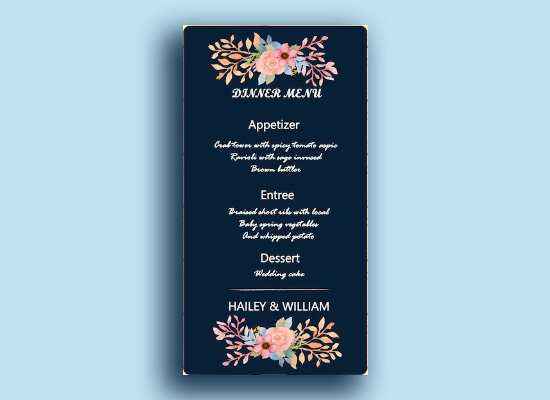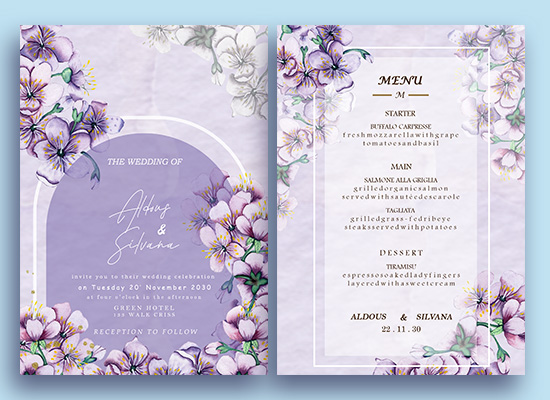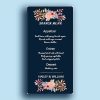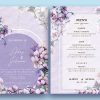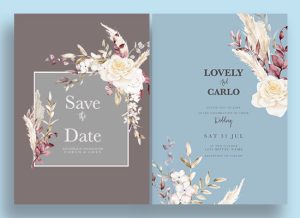Short Description
Wedding Menu
Please select artwork files:

Related Products
Additional Information
Wedding Menus
Create a stunning wedding menu with custom designs! Elegant and personalized, it adds a touch of sophistication to your special day.
Wedding Menus: Crafting the Perfect Culinary Experience
A wedding menu is more than just a list of food items; it’s a carefully curated selection of culinary delights that reflects the couple’s tastes and the overall theme of their special day. From the appetizers to the main courses and desserts, a well-planned wedding menu plays a vital role in enhancing the dining experience for guests while complementing the wedding’s atmosphere. This guide will explore the importance of wedding menus, elements to consider when creating one, popular menu styles, and tips for crafting the perfect culinary experience for your big day.
The Importance of a Wedding Menu
- Setting the Tone:
- The wedding menu helps set the tone for the celebration. Whether the couple opts for a formal sit-down dinner, a casual buffet, or a trendy food truck, the menu communicates the overall style and ambiance of the wedding. For instance, a rustic wedding might feature hearty comfort foods, while a black-tie affair may offer elegant gourmet dishes.
- Reflecting Personal Taste:
- A wedding menu provides an opportunity for couples to express their culinary preferences and cultural backgrounds. Including dishes that hold personal significance, such as family recipes or traditional cuisine, can make the menu more meaningful and memorable for the couple and their guests.
- Creating a Memorable Experience:
- Good food can elevate a wedding celebration, leaving guests with lasting memories. A thoughtfully crafted menu can impress attendees and spark conversations, ensuring that the dining experience is a highlight of the event.
- Accommodating Dietary Needs:
- Weddings bring together a diverse group of people with varying dietary restrictions and preferences. A well-planned menu can accommodate guests with specific needs, such as vegetarian, vegan, gluten-free, or allergen-free options. This consideration shows thoughtfulness and hospitality, ensuring that all guests feel included.
Key Elements to Consider When Creating a Wedding Menu
- Theme and Style:
- The wedding theme and style play a significant role in menu planning. Consider whether the event is formal, semi-formal, or casual, and let this guide the menu choices. A rustic-themed wedding may incorporate farm-to-table dishes, while a beach wedding might feature fresh seafood and tropical flavors.
- Seasonality:
- Utilizing seasonal ingredients can enhance the menu’s freshness and flavor. Seasonal produce not only tastes better but can also be more cost-effective. Consider incorporating local ingredients that celebrate the region’s culinary offerings.
- Guest Count:
- Knowing the guest count is crucial when planning the menu. This information will help determine portion sizes and the number of dishes to include. It’s also important to communicate with the caterer or chef to ensure they can accommodate the number of guests.
- Courses and Structure:
- Decide on the menu structure, including the number of courses. Common formats include:
- Plated Dinner: A formal option where each course is served individually to guests.
- Buffet: Guests serve themselves from a selection of dishes, allowing for variety and personalization.
- Family Style: Dishes are placed on the table for guests to share, promoting a communal dining experience.
- Food Stations: Various food stations offer different cuisines or types of dishes, providing an interactive dining experience.
- Beverage Pairing:
- A well-curated beverage selection can enhance the dining experience. Consider pairing wines or cocktails with specific courses or offering a signature drink that reflects the couple’s tastes. It’s also essential to include non-alcoholic options for guests who do not drink.
Popular Wedding Menu Styles
- Traditional Wedding Menu:
- A traditional menu typically includes a formal three-course meal: an appetizer, a main course, and a dessert. Classic options like salad, beef, chicken, or fish often dominate the menu, along with a choice of sides.
- Buffet Style:
- Buffets allow for a wide variety of dishes and cater to different tastes. This style is often more relaxed, allowing guests to mingle and choose their meals. Popular buffet items might include pasta stations, carving stations, and assorted salads.
- Family-Style:
- Family-style service promotes sharing and interaction among guests. Large platters of food are placed on each table, allowing guests to serve themselves. This style encourages conversation and creates a warm, inviting atmosphere.
- Themed Menus:
- Many couples opt for themed menus that reflect their personalities or travel experiences. For example, a couple who loves Italian cuisine might offer a menu featuring pasta, risotto, and tiramisu. Alternatively, a couple who enjoys global cuisines might create an international menu with dishes from various countries.
- Cocktail Reception:
- For more casual or intimate weddings, a cocktail reception with hors d’oeuvres can be a fantastic option. Small bites, such as sliders, skewers, and tapas, allow guests to mingle and sample various flavors.
- Dessert Stations:
- Beyond the traditional wedding cake, many couples are incorporating dessert stations featuring a variety of sweet treats. Options may include cupcakes, macarons, cookies, or a candy bar, allowing guests to indulge their sweet tooth.
Tips for Crafting the Perfect Wedding Menu
- Taste Testing:
- Schedule taste-testing sessions with your caterer or chef. This allows couples to sample dishes and make any necessary adjustments. Taste testing ensures that the food meets expectations and fits the couple’s vision.
- Balance and Variety:
- Aim for a balance of flavors and textures in the menu. Include a mix of proteins, vegetarian options, and various cooking styles to cater to different preferences. Variety can make the meal more exciting and satisfying.
- Consider Presentation:
- The presentation of food can significantly enhance the dining experience. Work with your caterer to ensure that dishes are beautifully plated or displayed. Consider using decorative serving ware or garnishes that align with the wedding theme.
- Personal Touches:
- Adding personal touches can make the menu more meaningful. Consider incorporating favorite foods, family recipes, or cultural dishes that hold special significance for the couple.
- Communicate with Guests:
- Provide guests with clear information about the menu, including any potential allergens. Consider including a note in the wedding program or on place cards that details the meal options.
- Budget Considerations:
- Keep budget constraints in mind when planning the menu. Prioritize essential items and explore options for cost-effective alternatives without sacrificing quality.
Conclusion
A thoughtfully crafted wedding menu can elevate the overall dining experience, leaving a lasting impression on guests. From traditional multi-course meals to casual buffet spreads, the options are limitless. By considering the couple’s tastes, the wedding theme, and the dietary needs of guests, a memorable and enjoyable culinary experience can be achieved. Ultimately, the wedding menu should reflect the couple’s unique story and set the stage for a celebration filled with love, joy, and unforgettable flavors.
Get Your Quote
My Account
About Us
Our Products
Contact
Follow Us On
We Accept




